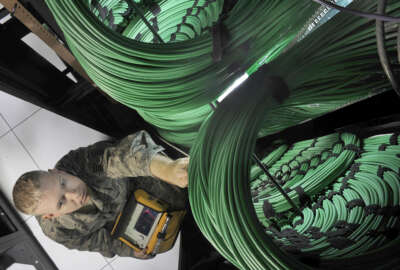
DoD expands 5G experimentation sites to 12 installations
The military will try everything from ship-wide connectivity to augmented reality support in its newest 5G push.
The Defense Department is adding seven new installation sites in its second round of 5G technology testing and experimentation.
The additional sites bring the total number of installations hosting 5G testing to 12. DoD announced the selection of four bases last year and then added Nellis Air Force Base in Nevada in May.
“This latest tranche builds upon DoD’s previously announced 5G prototyping and experimentation plan, as well as the recently released Department of Defense 5G strategy,” Joseph Evans, DoD technical director of 5G, said Wednesday at the Pentagon via teleconference with reporters. “The bases that were selected were selected for their ability for large scale test facilities to enable rapid experimentation, as well as dual-use application prototyping.”
The new bases and their testing specialties consist of:
- Ship-wide/Pier Connectivity at Naval Station Norfolk
- Enhancing Aircraft Mission Readiness at Joint Base Pearl Harbor-Hickam
- Augmented Reality Support of Maintenance and Training at Joint Base San Antonio
- Wireless Connectivity for Forward Operating Bases (FOB) and Tactical Operations Centers (TOC) at the NTC at Fort Irwin and Fort Hood, Texas
- Wireless Connectivity for FOBs and TOCs at Camp Pendleton
- DoD 5G Core Security Experimentation Network at Joint Base San Antonio and multiple remote locations
- Bi-directional Spectrum Sharing between DoD and commercial entities at Tinker Air Force Base
“Installation selection criteria included factors such as mature fiber and wireless infrastructure, streamlined access to spectrum bands and prototype, test areas and training range access,” Evans said.
In the coming weeks DoD will solicit industry for proposals to experiment at these bases.
DoD plans to have test beds stood up and industry working at the sites by the end of the fall.
“5G technology is vital to maintaining America’s military and economic advantages,” Evans said. “5G will be the advent of ubiquitous connectivity, which is the connectivity of everything and everywhere through wireless communications. It is a transformational technology. With this latest tranche of bases and experiments, DoD is ensuring our military can make use of 5G capabilities based on the innovations from U.S. industries.”
DoD is finding it’s falling behind in some areas of 5G as Chinese companies jump ahead in creating network infrastructure.
Evans said he thinks the U.S. is competitive in the 5G space.
“Obviously there are challenges with this and out potential adversaries, but we don’t think we are behind in any sense,” Evans said. “The U.S. has been leaning forward in the use of 4G technologies, so there is some experience with that including operational use of that technology. We believe we can leverage that experience with some of the new efforts we are ramping up.”
The initial tranche one bases are already working on awarding contracts based on zero-trust security and 5G networks.
Getting to a completely 5G world is not just maturing the technologies though.
“You have to lay the groundwork from a bigger picture perspective so that everyone knows where we are going with this,” Fred Moorefield, DoD deputy chief information officer for command control and communications said during a virtual AFCEA event.
Part of that is the DoD 5G strategy, which was introduced last month.
“DoD requires access to resilient, and protected 5G capabilities and spectrum,” the strategy states. “Therefore, the DoD will support national efforts to: advance U.S. and partner 5G capabilities, promote awareness of 5G risks to national security and develop approaches to protect 5G infrastructure and technologies.”
The strategy also outlines promoting technology development, militating and operating through vulnerabilities, influencing 5G standards and policies and engaging partners as lines of effort to achieve DoD’s objectives.
Evans said in order to do that, things like cybersecurity standards need to change and stay updated.
“5G is going to be a game changer,” Moorefield said. “One underpinning aspect of that is spectrum and how we share the airwaves with 5G and 6G and 7G what’s coming. In the department we will want more access. I think 5G will require an overarching overhaul of how we do business.”
Copyright © 2025 Federal News Network. All rights reserved. This website is not intended for users located within the European Economic Area.
Scott Maucione is a defense reporter for Federal News Network and reports on human capital, workforce and the Defense Department at-large.
Follow @smaucioneWFED






